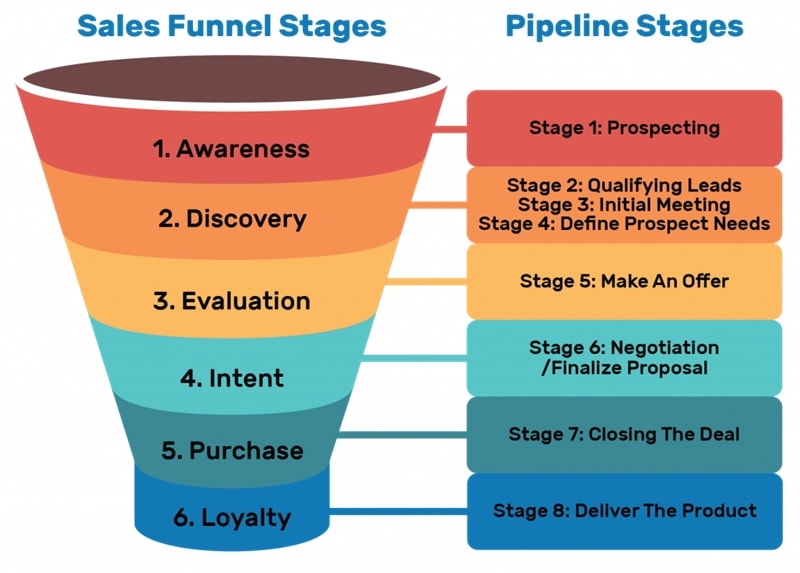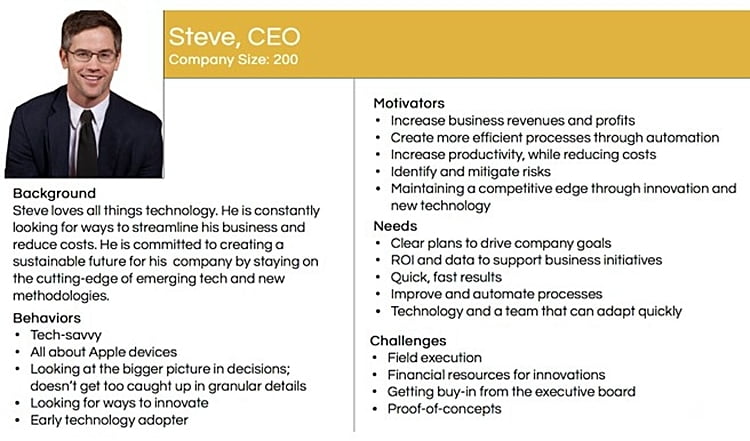by Claron Kinny for MarketingProfs
The B2B sales pipeline is a game-changer, because it helps identify target prospects, build tailored messages, and facilitate follow up on leads in ways that save you time, money, and resources.
Sales pipelines allow companies to communicate with relevant customers and guide them through different phases of their journey until a purchase occurs.
This article will provide a step-by-step guide on how to build a B2B sales pipeline for your company.
But first: What is a B2B sales pipeline?
A B2B sales pipeline is a visual representation of what sales and marketing teams do at every stage of the sales process.
In other words, it is how you deal with your potential customers in their buyer’s journey from first interest to final purchase across all channels.
The following infographic shows a sample sales pipeline and corresponding sales funnel stages.
A sales funnel differs from a sales pipeline in that it shows the stages that customers go through in their journey to purchase (and beyond). Note, too, that this representation is only an example. The B2B sales pipeline stages may vary depending on the industry/business.

Ultimately, a sales pipeline is a road map for B2B sales teams. It allows them to prioritize potential prospects and optimize conversion opportunities.
A sales pipeline also helps companies anticipate revenue and monitor sales goals. It enables B2B businesses to prioritize their resources and allocate them where they will have the greatest impact.
Three Standard Stages of a B2B Sales Pipeline
Although the number of stages in a B2B sales pipeline may vary per business, a standard B2B sales pipeline always includes the following three stages.
1. Lead Qualification
Lead qualification involves assessing the quality and potential of each lead to determine whether they are a good fit for the products or services a business sells. This stage helps you prioritize your efforts and resources on those most likely to convert into paying customers.
You can perform lead qualification by clearly defining your ideal customer profile, implementing a solid communication strategy, and developing a lead scoring system.
Clearly defining your ideal customer profile is crucial to ensuring that your marketing teams are targeting the right B2B prospects. You must understand the characteristics and demographics of your ideal customer, including their industry, company size, job title, buying journey, and specific pain points.

Source: Superoffice.com
You can collect that information by conducting market research, analyzing your current customer database, and collecting feedback from your sales reps.
A solid communication strategy is also crucial for scoring and qualifying leads. It helps organizations gather real-time data about leads’ requirements, interests, and problem areas.
However, ensure you have the right tools in place. Think carefully about how your B2B potential customers like to be contacted. You might consider a hosted phone system, email, or video conferencing. Choosing the right method allows you to gather the data you need for accurate scoring and qualifying without irking prospective customers.
Then, you can develop a lead scoring system, which involves assigning a numerical value to each potential buyer based on their level of interest, engagement, and fit with your ideal customer profile.
Leads can be categorize and prioritized as Marketing-qualified leads (MQL) and Sales-qualified leads(SQL); often, the former are early-stage leads, whereas the latter are those who show higher intent and are more likely to convert into paying customers.

Source: Encharge
Your sales reps can use the lead scoring system to decide what happens to your leads.
For example, MQLs can be nurtured through targeted content addressing their pain points and challenges. Doing so helps ensure that MQLs become SQLs. On the other hand, SQLs can receive more personalized offers from your sales team, focusing on closing the deal and converting them into loyal customers.
We’ll talk more about lead nurturing in the next section. But just take a look at the chart above to get an idea of how the lead scoring system is used.
